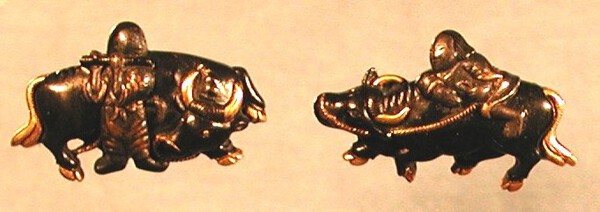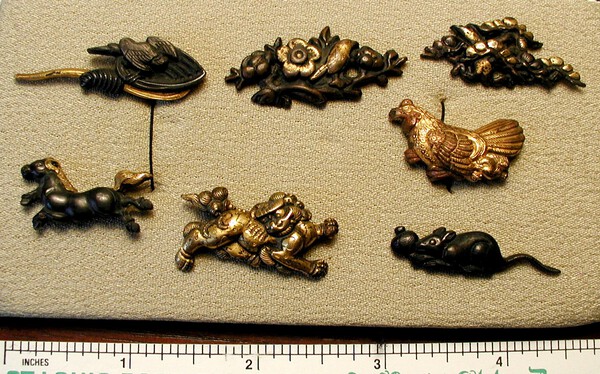-
Posts
703 -
Joined
-
Last visited
-
Days Won
4
Everything posted by Ron STL
-
Thank you Morita san, this is interesting to learn. Is there a Horikawa family name mentioned also and maybe the he requested the carving? I need to search out an earlier posting on this kowakizashi. It has two narrow hi that are totally filled with kanji; I believe they were sutra prayers if I recall correctly. Higaki Kunimasa must had great patience and great eyes to carve the many kanji into the hi of this blade. Ron STL
-
Attached is a photo of a kinpun mei done by someone other than one of the Hon'ami, as far as I can tell. Does anyone recognize this appriaser and might have some information on him? Also how would this translate? A long shot, but worth asking about. Also have an interesting mei under translation help...Ron STL
-
Here is a challenge that I'm hoping somebody and help with. Attached, show the ura of the nakago (very small nakago, I might add) on a tanto/kowakizashi by a Munesada (Genroku period). The date line is Genroku 4 and then zodiak form. The right hand column of kanji is what might tell a lot about this little blade, but it is beyond my reading ability. Also, below the date line is another very tiny inscription which may or may not be readable. I've gotten some good photos (good as possible, for me) and have pulled out this last section as a detail. Also, I've shown both of these photos as "negatives" which often makes it easier to "see" an inscription. Hopefully these photos will allow somebody to make sense of this inscription and explain it to us. I hope everyone finds this as interesting as I have! Thanks. Ron STL
-
Well put, Peter. My first contact with Neil was in 1973 or 1974. He soon became "one of the boys" who came over and talked swords with a few of "the boys" downstairs in my bare-bones basement hideaway. Lots of swords turned up regularly in those days, so there was always a lot of new finds to enjoy. Neil was always a talker and a thinker which resulted in lots of good sword study and some tall tails, too. Always a time to reminsce when one of our "old timers" pass on. Ron STL
-
Thanks Marcus, I'll pass this along. It turns out this did not come from our local museum, but posted on Bowen's Token list. Poster's email is Soldiers Memorial...should have remembered that from earlier posting. Still, an interesting arm band/historical note. Ron STL
-
Our local Soldiers Memorial museum asked for a translation of this arm band. I see Showa, is that a form of 4...and I suspect the rest is a name. I'll pass on a correct reading of this for the museum, if available. Thanks. Ron STL
-
Favorite school? That has always been a difficult question for me. Most people, especially Europeans, tend to think of "collecting" as collecting (concentrating on) a specific school, type, whatever... After fifty years I sometimes sit back and laugh at myself for doing just the opposite of this. I have always found myself collecting swords from just about any school or era, if it is an exciting sword with much to enjoy about it. So today, while the early swords -- kamakura/nambokucho eras -- continue to excite me because of their eras, and the wonderful smiths working then, I can become equally excited over the works of shinshinto smiths such as Naotane and Jirotaro Naokatsu and his son, Yamon Naokatsu. Then a sword by Yoshihara Kuniie is placed into my hands and that too deserves to be admired! If anything, I find that blades from Muromachi era are the least found in my collection. Let's face it, a good sword is still a good sword to be enjoyed and admired, from any era! By the way, if it works out as planned, I'll have a display of swords and tsuba by Jirotaro Naokatsu out for study at the next Chicago show, if table space is available. Ron STL
-
-
My post of 12/21 of seven orphans...if anyone wants the lot for what?...$300?...you can have them, post paid. Ron STL
-
Keith - It's hard to tell for sure just what quality these are, but they do appear to be a matched pair. Both have horse trappings...saddle, riding crop, etc. It would be important not to seperate these from one another. Ron STL
-
-
John, I have no photo of the full sword, just this photo of the ura side of the nakago. Sorry. I do not have easy access to the sword. Ron STL
-
Thanks George, for the clear (and logical) explanation of the cuts by number, not number of bodies cut through. I may have read that before but if so, I had forgotten it. I've always wanted to understand these test inscriptions better and to put together a worthwhile article about them with multiple examples, but this never got off the ground. I still have a file of test examples copied from various sources when they turned up. The posts topic inscription was questioned by me under another recent post, asking about the use of gold lacquer instead of the usual gold inlaid tests more typically found. Maybe I'll go ahead and attach the full test inscription here, now that I have a good, clear (as possible) photo of the nakago. Perhaps others might enjoy seeing it. I should mention that I do not have this sword, but was asked to examine it a few weeks ago. Since a friend is trying to buy it, I've stayed only an observer, let's say. It also has a kinpun attribution to No-Sada (Kanesada). Interesting sword but with a badly scratched and gouged kissaki which may or may not be fully restored by polishing. (By the way, I thought I posted the above earlier today but if so, I don't see it anywhere. Sorry if I'm repeating myself here.) Ron STL
-
This is an inscription on a cutting test by Yamano Kajiro Hisateru. I can read: Futatsu no do ---but which style of cut is this? I have been unable to find those two characters on any charts. Thanks! Ron STL
-
Peter and all - I'm happy to see these arrowhead menuki finally come under discussion, Peter. For the others info, Peter's shinshinto wakizashi was part of a 60-odd sword collection, the property of a elderly (100 year old) retired stockbroker. He bought most if not all of his swords at local St. Louis gun shows, I'm sure. His "collection" was a haphazard bunch of stuff. Nothing was ever taken care of and most still had $5 and $10 price tags on them along with years of dust and crud. I was first shown this collection back in 1978 and asked to pick out a few swords for the upcoming 1979 Chicago shinsa, which I did. In 2004 this fellowed died and I bought the entire collection from his estate. Four of the swords including Peter's wakizashi went to Benson for polish. Later, I decided to sell the wakizashi and knowing Peter's archeology background, directed this one to him because of the arrowhead menuki. Could it be that this sword and the other tsuka were once together? Anything is possible. This old man bought his sword right after WWII so I'm sure they were plentiful (and cheap) at St. Louis gun shows. (Sadly, I didn't know about Japanese swords back in the '40s.) Just sharing some sword history today. Good to see you still have these things, Peter. Ron STL
-
That's what surprised me with the sword I examined, Mike. It was definitely all done in gold lacquer, both the attribution and the test inscription. Some of the lacquer actually was worn away. On kinzogan test inscriptions I recall reading somewhere that you should see the yasurimei actually across the inlaid test kanji, which is (I believe) that way it is on the two test blades I own. Ron STL
-
An O-suriage katana with kinpun attribution and cutting test was shown to me today. Sorry, no photos to share. It surprised me to see a gold lacquer cutting test since I thought all cutting test inscriptions were inlaid gold or simply carved onto the nakago. Anyone have any comments of kinpun cutting test inscriptions? At the moment I don't recall who the tester was -- info misplaced somewhere in my computer -- but the inscription looked right when compared to other book examples for the tester. Comments? Ron STL
-
You young computer wizards amaze me! Too much for this 77 year old! About the shinogi-ji. One of my earlier polishes from Kajihara when John Yumoto was handling his orders was a shodai Hizen Masahiro, literally a "perfect" sword let's say. Kajihara left the shinogi-ji not so burnished so as to show the jigane in the ji. John commented on this when the sword came back saying it must had been what the polisher wanted you to see. I will say it is the only sword in my collection that had this kind of non-burnishing (less burnishing). The Yasuhiro looks absolutely beautiful, I might add. Ron STL
-
It was either in Albert Yamanaka's Nihonto Newsletters or perhaps in Sword and Same' it was mentioned if the edge is left side or right side (I don't recall the order), the sword was either meant to "cut heads" or "cut bamboo." Factual? It sure impress me years ago when I had such a blade. This is the first of these Kaifu-to that I've seen in many years and probably the first, in mounts. All I've come across were in shirasaya. I put together an article on these swords for the JSS/US Newsletter back in the 1970s or so. Today, there is probably ten times that much info available, I'm sure. Ron STL
-
Thanks Chris, that's good news. Appreciate the imput. Ron STL
-
This gunto mounted katana signed: Toshihide saku and dated 1939 was brought over for study this weekend. While the sword does look as it should for Horii Toshihide, I am concerned (puzzled) by the way the character "Hide" is made. All other book examples found, "Hide" is carved more compact or pulled together, let's say. It would be interesting to read your thoughts on the mei. The sword is a WWII bring-back. I recall Chris telling be me before that there are superior works by Toshihide but also lesser swords that were made to fill the demands for swords during the war. I wonder if this might be one of them? Again, all comments welcomed. Ron STL
-
Thanks Chris, I thought that looked like Ichimonji but didn't believe it. Looks like a gift, right? Interesting to see this on such a "rough" (so to speak) WWII item that shows only basic swordsmithing qualities. Rather intersting though. Chris, thanks for coming through once again! Ron STL
-
A friend came by today with a typical WWII "kamikaze" tanto as pictured in Fuller-Gregory. I'm pretty sure the nakago has a patriotic saying inscribed on it, but can not read it. It would be interesting to know what it says. Anybody help??? Thanks! Ron STL
-
Have owned one of these. Initially, the thought was the shape resembled Mt. Fuji. Later, it looked like the wings of a dragon fly. Somewhere along the line, one was found clearly being a dragonfly, eyes and all. The one I had also had brass inlay on the edge. Rather interesting tsuba, actually. Ron STL




















